In the rich tapestry of Aztec mythology, where gods and goddesses intertwine with the cosmos and human existence, Coatlicue stands as a pivotal figure. The Aztecs, a civilization known for their intricate belief systems and profound cultural practices, revered Coatlicue not just as a deity but as a symbol of life, death, and rebirth. She embodies the earth itself, a testament to the Aztecs’ deep connection with nature and the universe. Coatlicue’s story, wrapped in layers of symbolism and mystique, offers a window into the heart of Aztec culture, reflecting their values, fears, and aspirations. Her significance in Aztec mythology goes beyond mere worship; it represents a complex understanding of the world’s dualities and the eternal cycle of creation and destruction. Please provide the next part of the outline.
| Attribute | Coatlicue Information |
|---|---|
| Origin | Aztec Mythology |
| Deity Type | Goddess of Earth, Fertility, and Life |
| Role | Goddess associated with earth, fertility, life, and death |
| Appearance | Often depicted as a monstrous figure with a skirt of snakes and a necklace of hearts, skulls, and hands |
| Mother of Gods | Considered the mother of the gods, including Huitzilopochtli |
| Cultural Impact | A significant figure in Aztec religion, symbolizing the cyclical nature of life and death |
| Depictions | Featured in Aztec art and rituals, often as a powerful and primordial goddess |
1. Historical Context and Mythological Significance
Historical Background of the Aztec Civilization
The Aztec Empire, flourishing in central Mexico from the 14th to the 16th century, was a civilization of profound complexity and achievement. Known for their architectural prowess, intricate calendrical systems, and rich cultural traditions, the Aztecs created a society that was both sophisticated and deeply spiritual. Their capital, Tenochtitlan, was a marvel of urban planning and engineering, reflecting their advanced understanding of various sciences and arts.
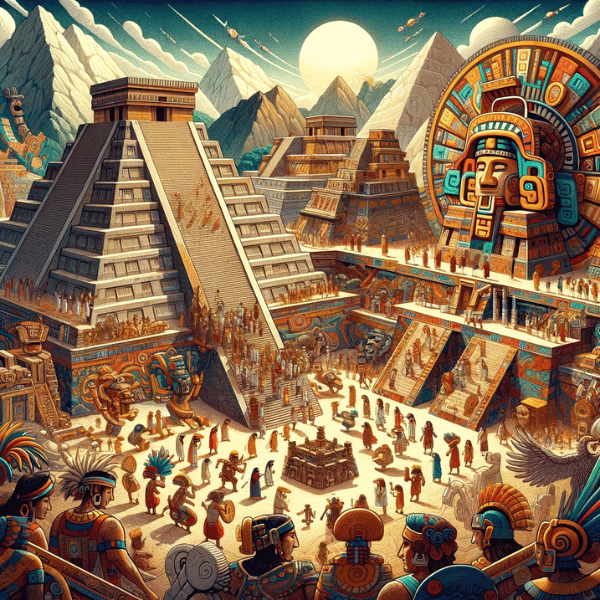
Coatlicue’s Role and Symbolism
Coatlicue, the “Serpent Skirted” goddess, occupied a central role in Aztec mythology. She was revered as the mother of gods, including Huitzilopochtli, the god of sun and war. Coatlicue’s depiction, often as a fearsome figure draped in snakes and adorned with skulls, symbolized the earth’s power to give life and take it away. Her narrative embodies the Aztec’s view of the universe as a place of perpetual struggle and balance between opposing forces.
Comparative Analysis with Similar Deities
Coatlicue’s attributes and mythology bear intriguing similarities to other earth and mother goddesses across various cultures. For instance, Gaia of Greek mythology, also considered a Mother Earth figure, shares the trait of being the progenitor of life. Similarly, the Hindu goddess Kali, with her fearsome aspect and association with time and change, echoes aspects of Coatlicue’s dual nature of creation and destruction. These cross-cultural parallels highlight the universal themes in human civilization’s attempts to understand and personify the forces of nature.
2. The Legend of Coatlicue
Narrative of Coatlicue’s Mythology
Coatlicue, known as the goddess of earth and fire, has a legend that is as captivating as it is symbolic. According to Aztec mythology, Coatlicue was sweeping the temple on Coatepec (Snake Mountain) when a ball of feathers fell from the sky. She placed it in her waistband, an act that miraculously impregnated her. This divine conception led to the birth of Huitzilopochtli, the god of sun and war. However, Coatlicue’s daughter, Coyolxauhqui, and her brothers, the Centzon Huitznahua, disapproved of this miraculous birth and plotted to kill their mother. In a dramatic twist, Huitzilopochtli emerged fully armed from Coatlicue’s womb and defended her, leading to the destruction of his siblings.
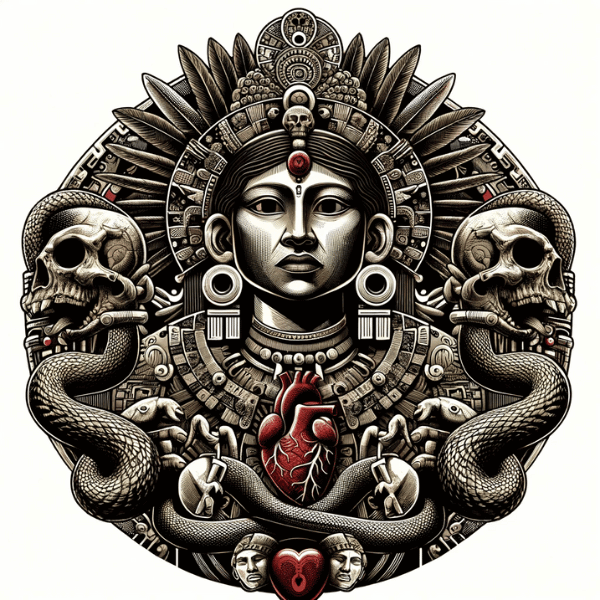
Analysis of the Symbolism Behind Her Story
The legend of Coatlicue is rich in symbolic meanings. Her impregnation by a ball of feathers represents the fertility and creative power of the earth, where even the slightest touch of the divine can lead to creation. The conflict between Coatlicue’s children symbolizes the perpetual cosmic struggle between order and chaos, life and death, day and night. Huitzilopochtli’s emergence and defense of his mother can be seen as a metaphor for the sun’s daily battle to rise, bringing light and warmth, conquering the darkness of night. Coatlicue’s narrative is not just a myth; it’s an allegory of the natural cycles and cosmic events that shaped the Aztec’s understanding of the world.
3. Iconography and Cultural Depictions
Coatlicue’s Iconography
Coatlicue’s representation in Aztec art is both striking and symbolic. She is typically depicted as a fearsome figure, wearing a skirt made of writhing snakes and a necklace of human hearts and hands, with a skull as a pendant. Her two faces, one facing forward and the other backward, signify her ability to see into the past and future. This iconography is vividly captured in the colossal basalt statue of Coatlicue, discovered in Mexico City, which stands as a testament to the Aztecs’ sculptural genius and their reverence for this deity.
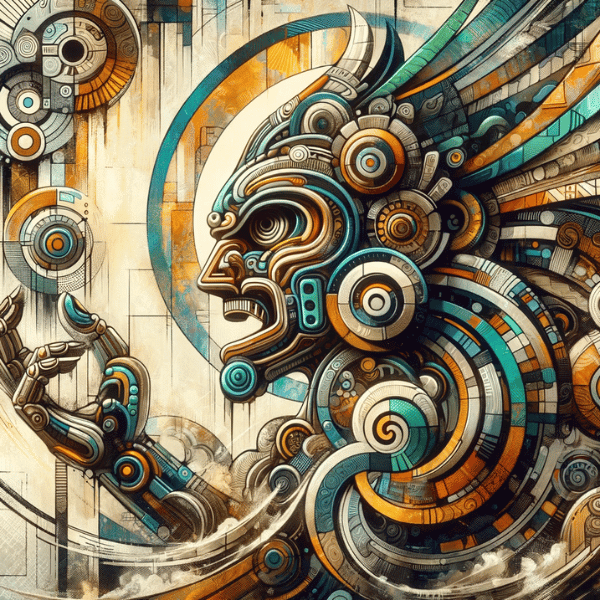
How Depictions Reflect Aztec Beliefs and Values
The imagery associated with Coatlicue in Aztec art is deeply intertwined with their cosmology and values. The serpents, a common motif in Aztec art, symbolize rebirth and the earth’s regenerative powers. The necklace of hearts and hands underlines the Aztec belief in sacrifice as an essential part of the cosmic balance and renewal. Her dual-faced depiction highlights the Aztec understanding of the duality of existence – life and death, creation and destruction, all being part of a continuous cycle. These depictions were not mere artistic expressions but were imbued with profound religious significance, reflecting the core beliefs and values of Aztec society.
5. Coatlicue in Modern Context
Coatlicue’s Influence on Contemporary Culture and Art
Coatlicue’s enduring legacy transcends ancient Aztec mythology, permeating modern culture and art. She has become a symbol of indigenous identity and cultural resilience, often depicted in contemporary Mexican art. Artists and writers invoke her image to explore themes of creation, destruction, and the maternal figure’s power. In modern sculpture and painting, Coatlicue is frequently reimagined, melding ancient iconography with contemporary artistic styles, illustrating the timeless nature of her myth.
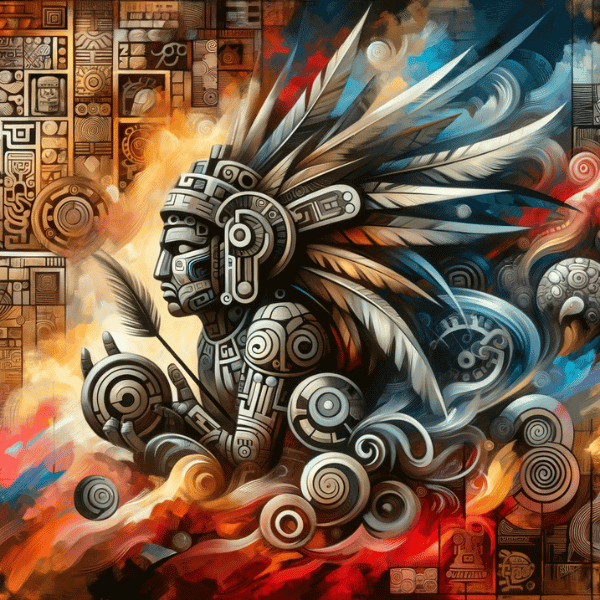
Insights from Modern Artists and Scholars
Contemporary artists and scholars often cite Coatlicue as an inspiration for exploring deeper human experiences. Renowned Mexican artist Frida Kahlo, for example, referenced Aztec mythology in her work, using powerful symbols to express her identity and struggles. In academia, scholars like Alfredo López Austin have extensively studied Coatlicue, emphasizing her importance in understanding Mesoamerican views of the cosmos and femininity. These perspectives underscore how Coatlicue continues to inspire and provoke thought in the modern world.
Relevance of Ancient Myths in Today’s World
Ancient myths like Coatlicue’s retain their relevance by offering insights into universal human experiences. They provide a window into how our ancestors made sense of the world, and continue to influence our contemporary understanding of life, nature, and the divine. Coatlicue’s story, with its themes of creation, transformation, and duality, resonates with modern narratives about change and resilience, making her more than just a mythological figure – she’s a symbol of the enduring human spirit.
5. Comparative Mythology
Coatlicue and Similar Figures in World Mythologies
Coatlicue shares several attributes with mother goddesses and creators in various mythologies. For instance, in Greek mythology, Gaia, the personification of Earth, parallels Coatlicue in her role as the mother of many deities. Both Gaia and Coatlicue are central to their respective mythologies as creators and nurturers, yet also embody the destructive aspects of nature. Similarly, the Hindu goddess Kali represents time, creation, destruction, and power, akin to Coatlicue’s embodiment of life cycles and dualities.
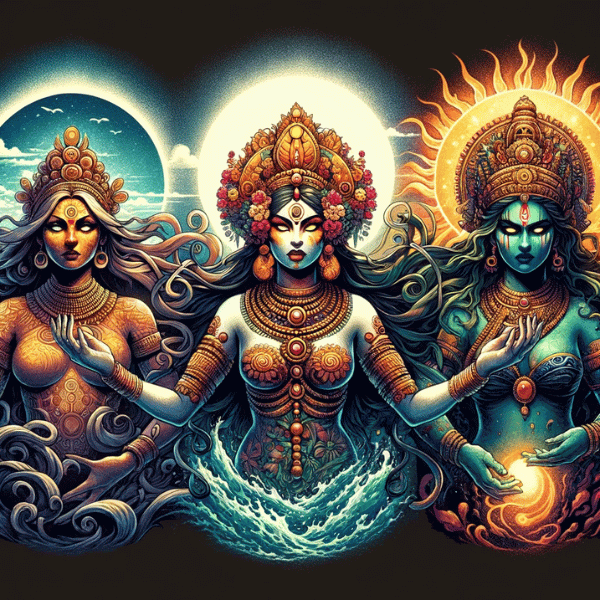
Common Themes Across Cultures
A common theme that emerges when comparing Coatlicue with these figures is the concept of life and death as intertwined forces. These deities often represent not just the nurturing aspect of motherhood but also the fierce and terrifying facets of nature. They symbolize the earth’s fertility and the inevitable decay, reflecting the universal understanding of nature’s dualistic character.
Divergent Portrayals and Cultural Interpretations
While there are similarities, the portrayal of these mother figures varies significantly across cultures, influenced by societal values and environmental contexts. For instance, Coatlicue’s depiction in Aztec culture, with her skirt of snakes and necklace of skulls, is starkly different from the often serene and verdant imagery of Gaia in Greek art. These differences highlight how various cultures perceive and represent the forces of nature, influenced by their unique experiences and surroundings.
6. Conclusion
The exploration of Coatlicue, the Aztec goddess, reveals much about the complexities and richness of Aztec mythology. Her depiction as a deity of life and death encapsulates the Aztecs’ profound connection with nature and their nuanced understanding of the universe’s dualistic nature. The enduring influence of Coatlicue in modern culture underscores not only her historical significance but also the timeless relevance of such myths. Through comparative mythology, we see universal themes of creation, destruction, and rebirth, reflecting shared human experiences across various cultures. These insights into Coatlicue and Aztec mythology enrich our understanding of ancient civilizations, highlighting their sophisticated worldviews and their lasting legacy on human thought and culture.
